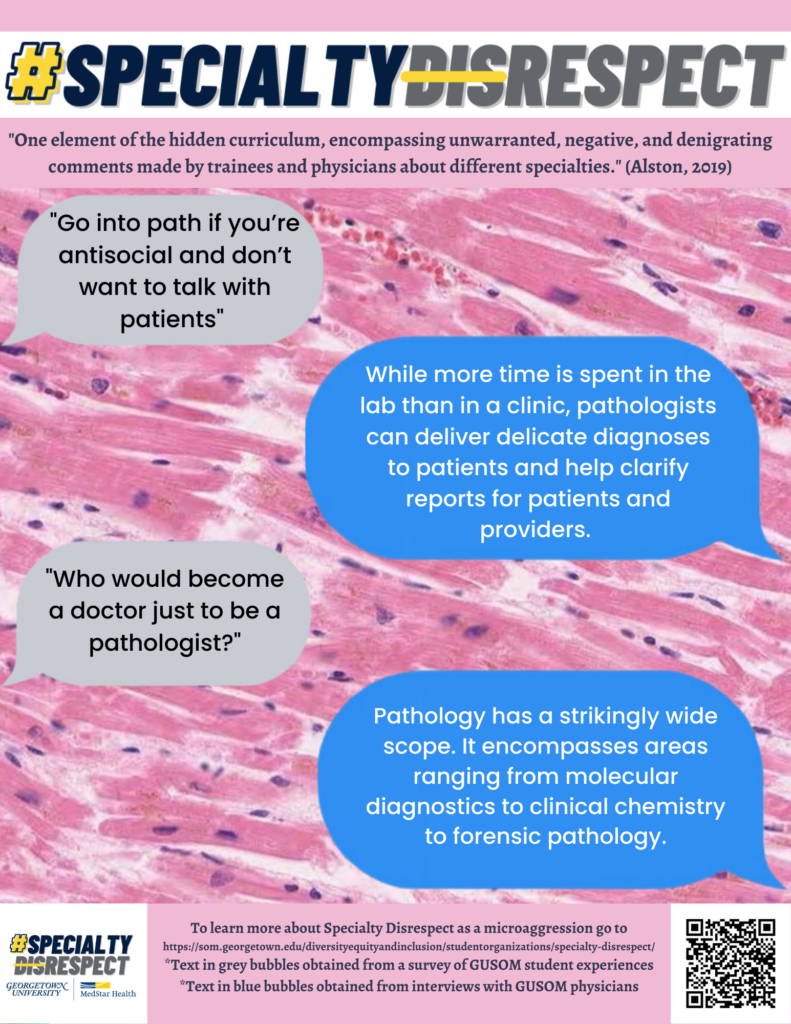Pathology

Fiction #1: “If you don’t like interacting with others, go into pathology”
FACT: In a standard four-year anatomic pathology /clinical pathology (AP/CP) residency, residents spend at least 18 monthson clinical pathology (CP) rotations including transfusion medicine, microbiology, and hematopathology. Each of these rotations offers numerous opportunities for patient interactions. Pathologists also frequently engagein academic education. Your medical school may have lectures taught by pathologists. In some hospitals, pathologists teach other subspecialties, particularly surgical specialties, about proper specimen handling, the appropriate use of interoperative consultations (frozensections), and various diagnoses. [1]
Fiction #2: “Who would become a doctor, just to become a pathologist”
FACT: Pathologists play a vital role in establishing a definitive diagnosis to enable a clinician to provide optimal care. This includes testing for the use of immunotherapy (i.e., PD-L1 testing)to equip oncologists with more treatment modalities. This is why pathologists are often known as “the doctor’s doctor” or a “medical detective.” [1]
Fiction #3: The only thing pathologist do is autopsies.
FACT: The field is so large you can choose how big a scope you want to have. Autopsies are a small portion of a pathology residency. Pathology residents in anatomic pathology must perform a certain number of autopsies in residency to become board certified. Some people will never want to do another autopsy and will find a job that does not require this. Others will find jobs where they can occasionally do autopsies to keep their skills up. Others still will build careers around only performing autopsies. One can decide how much they like them and select their career accordingly. [1]
Fiction #4:
Fact: Over the next five years there may be a national shortage of over 5,000 pathologists. This is a great time to consider pathology. Finding a job is more difficult if you are geographically restricted (which applies to any specialty) or if you have a super academic subspecialty (like one of my chosen subspecialties, bone and soft tissue pathology which is most prevalent at academic centers). [2]
Sources
1. Broadwater DR. The top 5 pathology myths –busted. College of American Pathologists.
2. Fitzhugh DV. Why pathology? A bunch of reasons you should consider my specialty (If you haven’t already). sheMD.
Read text version of this poster
[Background is image of hemangioblastoma]
[Top header in pink]
“Specialty Disrespect” in bold at the top. Underneath this title reads “Specialty Disrespect (SD) is an element of the hidden curriculum, encompassing unwarranted, negative, and denigrating comments made by trainees and physicians about different specialties. SD affects all specialties, touching most medical students by graduation (Alston, 2019).”
Poster that mimics an iphone messaging screen with fictional statements as receiving grey message bubbles and factual statements as sent blue message bubbles. This poster is about pathology. The fictional side reads “go into path if you’re anti-social and don’t want to talk with patients” and the factual response reads “while more time is spent in the lab than in a clinic, pathologists can deliver delicate diagnoses to patients and help clarify reports for patients and providers.” The next fictional response reads ‘”Who would become a doctor just to be a pathologist?” and the response reads “Pathology has a strikingly wide scope. It encompasses areas ranging from molecular diagnostics to clinical chemistry to forensic pathology.’
[Bottom header in pink]
On the left is the dark blue Office of Diversity and Inclusion Logo. On the right is a QR code that links to this webpage (som.georgetown.edu/specialty-respect). In the middle is “To learn more about SD as a microaggression go to som.georgetown.edu/specialty-respect”
